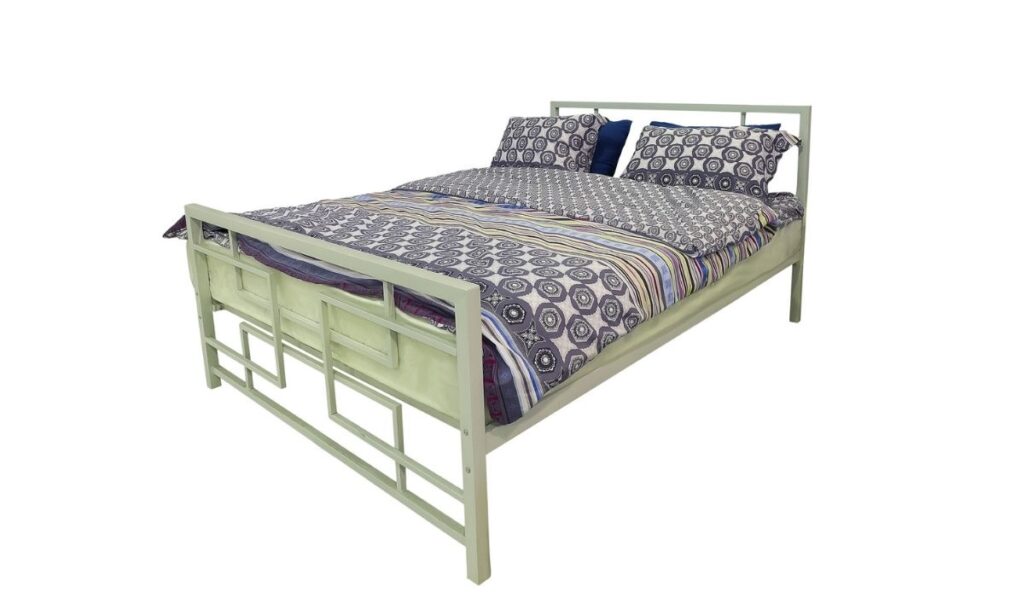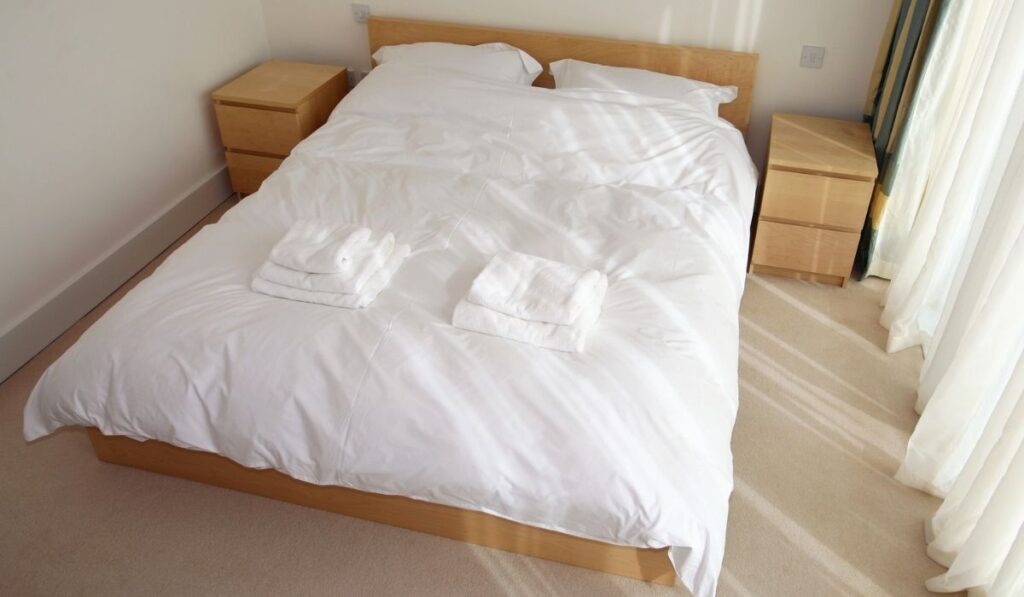Many terms in the bedding dictionary — pillow, mattress, comforter, duvet, duvet cover, etc. While some are pretty easy to understand and define, others aren’t, and you can easily mix up some terms. For instance, what’s a duvet cover? And what makes it different from a duvet or a comforter?
A duvet cover is a fabric used to enclose and protect a duvet. It comes with either a zipper or a button to tightly secure the duvet once it’s been inserted into the cover. Duvet covers are easier to wash and clean, and they can also be used with a comforter.
For a better perspective on the several functions of duvet covers, you need to know what materials they are made of, how to use them, and what distinguishes them from duvets and comforters. In addition, we’ll also look at some general questions that people ask about duvet covers.
What Is the Difference Between a Duvet and a Duvet Cover?

The two might have almost the same name, but they serve very different purposes. Still, they work together — a duvet needs a duvet cover, and a duvet cover needs a duvet.
The difference is in their definitions and what they’re used for. This is why it’s better to define both terms for you to understand what sets one apart from the other.
What Is a Duvet?
A duvet is a soft, fluffy quilt made of down feathers that originated in Europe. It is translated as a “down comforter” in French. Down is a soft feather located below the bird’s tougher outer feathers. This type of feather is very insulating.
Nowadays, duvets are typically filled with down, wool, or some other synthetic material. Duvets made from eiderdown, a scarce natural resource, are some of the most expensive and luxurious.
Duvets are usually white or light-colored but with different designs. The fabric used to enclose the filling material can be silk, cotton, or similar. Typically, duvets are meant to be used with a duvet cover, although some prefer to use the fabric as it is.
Some consider a duvet to be much better than a comforter because they’re generally warmer and fluffier — and they come with a conveniently removable (and washable) cover.
What Is a Duvet Cover?
As the name implies, a duvet cover is what you use to enclose your duvet, just as a pillowcase covers a pillow. A duvet cover usually has zippers, ties, or buttons, and it’s used to protect the duvet and keep it clean.
Unlike a duvet, duvet covers are easy to remove and throw in the washing machine. Once you have this cover, it becomes easier to maintain clean bedding. Using a duvet cover and washing it regularly means you might not need to clean the duvet for months or years at a time.
Once you have a duvet cover, you don’t need a top sheet anymore since they both serve the same function. One more thing that makes a duvet cover a great choice is that you can switch up the appearance and color of your bedding by simply changing the cover.
And thankfully, you don’t have to spend so much to own several duvet covers, so this is a great way to beautify your bed without breaking the bank.
What Are Duvet Covers Made Of?
Although many people pay more attention to the kind of fill that’s in a duvet, it’s also essential to consider the material of the duvet cover itself.
There are different material options available, but you should always aim for natural, lightweight, and breathable materials. Below are some fabric options you should consider when getting a duvet cover.
Cotton
Cotton duvet covers are the most common option because they are soft, light, and breathable. Cotton fabrics are known to regulate temperature well, so you can stay cool on a warm night and warm on a cold night. Above all, cotton duvet covers are easy to clean and maintain.
Cotton fabrics vary; there are different options to choose from. Organic cotton is the most popular of the bunch. A few options are the Tissaj 100% Organic Cotton Twin/Twin XL Duvet Cover (on Amazon) and the BIOWEAVE 100% Organic Cotton Cover Set (on Amazon). Besides the typical benefits of a duvet cover that we already mentioned, these organic cotton options also have the advantage of sustainable manufacturing processes.
Other cotton options include Egyptian cotton, Supima, etc., and they’re considered preferable to traditional cotton.
Silk
Silk is another breathable and lightweight material that works well with duvet covers. It’s a natural product, so it helps regulate body temperature much more than synthetic materials. However, silk duvet covers are more expensive than cotton covers. Nonetheless, the good part is that you don’t need to wash silk as often as other materials.
Whenever it’s time to wash your silk duvet cover, though, check out its care instructions to be sure you’re doing it the right way. Many silk duvet covers aren’t machine-washable. For those that are, it’s better to wash them in a protective cover. Two great silk duvet covers are the ZIMASILK 100% Mulberry Silk Duvet Cover (on Amazon) and the Pothuiny 5-Piece Satin Duvet Cover Set (on Amazon).
Flannel
Flannel duvet covers are another option you might want to consider. They’re incredibly soft, machine-washable, easy to clean, and long-lasting. One major disadvantage of this fabric is that it doesn’t regulate body temperature.
So while it may keep you warm on cold nights, it won’t keep you cool on a warm night — you’ll only get warmer. If you choose to buy flannel duvet covers, you might need to buy different fabrics for different seasons. The Bare Home Flannel Duvet Cover (on Amazon) and the Mellani Flannel Queen Duvet Cover (on Amazon) are two flannel duvet cover options you should consider.
How to Use a Duvet Cover
The function of a duvet cover is simple — to cover a duvet. Still, that doesn’t mean that it’s that easy to stuff your duvet into it, at least not as easy as placing a pillow in a pillowcase.
If you don’t insert the duvet into its cover properly, you’ll have to deal with rumples and unevenness, which can be annoying. So, what’s the proper way to use a duvet cover? How do you insert your duvet n the cover so that there are no folds or clumps?
You can achieve this by doing the following:
- Spread out the duvet: To begin, spread out your duvet on the bed. The entire material doesn’t have to be perfectly flat, but it has to be a good portion of it. Also, ensure that the edge and corners of the duvet are easy to reach.
- Turn the duvet cover inside out: There’s usually one side of a duvet cover that can be opened with a zipper or button. After unzipping or unbuttoning this opening, turn the duvet cover inside out. Ensure that the corners of the cover are smooth and not bunched up.
- Lay the duvet cover over the duvet: Place the duvet cover on top of your duvet and make sure that the bottom corners of the cover (the side without the opening) align with the duvet corners. You can clip or tie the corner of both fabrics together to make this easier. After securing the corners, lift up one side of the cover and slip your hand inside to hold the respective corners. It’s okay if you don’t have something to fasten the corners together. You can still hold the corners, but don’t let go.
- Turn over the duvet cover: Flip the cover over the duvet right side out, holding the corners firmly. Using your hands, gently shake the duvet as though fluffing it out, allowing the cover to follow the length of the duvet. You can manipulate the fit easier when the corners are secured by a tie or clip instead of your hands.
- Pull Down: You can let go and then pull the rest of the cover down to align the corners once the cover has fully engulfed the majority of the duvet. Please put them in their respective spots and secure them with ties or clips like the other two. Otherwise, smooth down the edges and zip or button the cover!
The process might be awkward at first, but the more you do it, the easier it’ll get.
You can also use clips to ensure that the duvet stays put in the cover, but that isn’t usually necessary since it stays put once it has been inserted. Some duvet covers also come with instructions on how to use them, so you can also look out for that.
Can You Put a Comforter in a Duvet Cover?
Yes, you can put a comforter in a duvet cover. It’s a great way to avoid having to wash your bulky comforter all the time. You have to insert the comforter into the duvet cover and zip or button it up to prevent it from slipping out or getting dirty.
Wash the duvet cover as often as you can or whenever you do your laundry. Usually, you use top sheets with comforters, but once you have a duvet cover, you don’t have to worry about using that anymore.
Are Duvets Warmer Than Comforters?

Duvets are usually warmer than comforters, but it depends on the type of fill materials and how often you fluff them. Duvet covers also influence how friendly a duvet can get; certain materials will add a fair amount of warmth to the situation.
A duvet might be the better option if you live in a cold climate. For warmer temperatures, a comforter might be preferable. Still, you might need an extra blanket on chilly nights if you use a comforter.
Can You Use a Duvet Cover by Itself?
Yes, you can use a duvet cover by itself since it’s just another piece of fabric. It can replace a quilt or summer blanket as a light covering. However, you should note that a duvet cover may not be as warm or cozy as a comforter or duvet since it’s meant mostly for protection and not to provide warmth.
